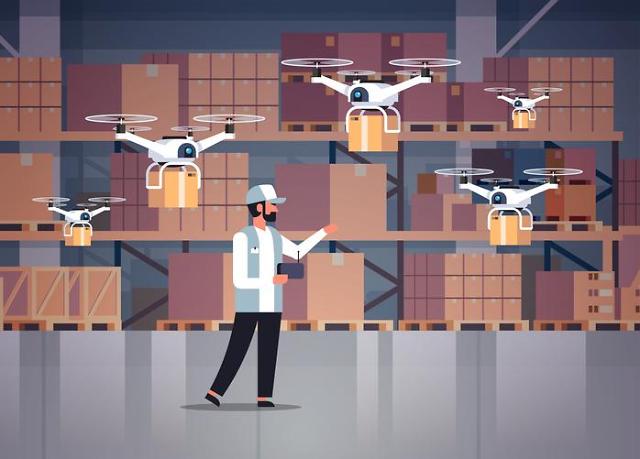
[Gettyimages Bank]
SEOUL — The South Korean government has partnered with a state research institute to demonstrate the cooperative operation of a delivery drone and autonomous robot that delivers groceries to customers living on a small island across a narrow strait.
Delivery drones and autonomous robots are widely researched by government organizations and private companies for their versatility and convenience. Drones were tested to deliver medication for people living on small islands. Woowa Brothers, the operator of South Korea’s favorite food delivery service app Baedal Minjok, has tested autonomous robots to deliver food this year.
The Ministry of Trade, Industry and Energy partnered with the state-run Electronics and Telecommunications Research Institute (ETRI) to demonstrate a combined drone service in Yeosu some 315 kilometers (195 miles) south of Seoul on October 13.
A customer in Jangdo, a small island off Yeosu, ordered groceries using an app provided by GS25, a major domestic convenience store franchise. When the order was made, a drone carrying groceries took off from a gas station operated by GS Caltex, a major refiner in South Korea, to fly across a narrow strait. During its flight, the drone reached a maximum altitude of about 80 meters (262 feet).
When the drone reached an open grassy area in Jangdo, it descended about one meter above an autonomous robot and softly dropped its load onto the tractor-like robot’s carrying compartment before flying back to its base station in Yeosu. The autonomous robot moved about 700 meters to reach its destination. The operation took about 10 minutes.
The delivery drone is capable of carrying up to 5 kilograms (11 pounds) and fly at a maximum speed of 60 km per hour. It can stay up in the air for up to 30 minutes. The autonomous robot can carry a maximum load of 150 kilograms per run and navigate for up to 300 minutes at a speed of 5.0 km per hour.
The demonstration is part of a 35.2 billion won ($30 million) state project to nurture non-face-to-face logistics and distribution infrastructure using 5G, drones, robots and artificial intelligence.
In June, GS Caltex used delivery drones to carry lunchboxes and drinks from a gas station in the southern resort island of Jeju to a nearby elementary school. GS Caltex plans to utilize its nationwide network of gas stations as the hub of a logistics system that can provide drone delivery, car-sharing, parcel delivery by vehicles and charging for eco-friendly cars.
South Korea with a web of 4G and 5G mobile communications has tested delivery drones in urban areas and hard-to-reach places. The demand for quick drone parcel deliveries is high among villagers that live on islands that dot the southwestern and southern coasts as logistics companies charge more for delivery to islands.
For the commercialization of delivery drones in urban areas, a food delivery service company demonstrated an auto-piloting drone in the western port city of Incheon in 2016 to deliver a rice cake stew dish to a customer.
For safety reasons, delivery companies have used drones on wheels. Woowa has successfully carried out a test run of Dilly, a six-wheeled autonomous drone.